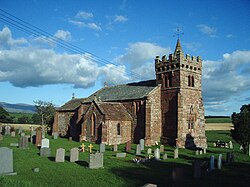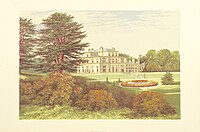Edenhall
| Edenhall | |
| Cumberland | |
|---|---|
 St Cuthbert's Church, Edenhall | |
| Location | |
| Grid reference: | NY566324 |
| Location: | 54°41’6"N, 2°40’23"W |
| Data | |
| Post town: | Penrith |
| Postcode: | CA11 |
| Dialling code: | 01768 |
| Local Government | |
| Council: | Westmorland & Furness |
| Parliamentary constituency: |
Penrith and The Border |
Edenhall is a clustered village in the Eden Valley in Cumberland, in the meadows beside a bow in the river opposite Langwathby, which is half a mile to the north. The A686 runs just to the north of Edenhall, and crosses the Eden here to Langwarthby.
Paths run from the village to a pretty riverside walk following the west bank of the River Eden.
The parish church in Edenhall is St Cuthbert's, which stands at the end of a lane just south-east of the main lane of the village.
The name Edenhall originates from Eden Hall house, the seat of the Musgrave family of Hartley Castle in Cumberland many of whom were members of the House of Commons.
Eden Hall

The original Eden Hall was extended in the 1700s from materials salvaged from the demolition of Hartley castle, the ancestral home of the Musgrave family. It was rebuilt in 1821 employing the architect Sir Robert Smirke and rebuilt again in white stone in an Italianate style in the late 1860s.
The hall was sold in the early 1900s, when the Musgrave family moved to London, and was demolished in 1934, leaving its 19th-century courtyard of stables and coach houses which has been divided into seven properties retaining some stables.[1][2]
The hall was noteworthy as the home of the Luck of Eden Hall, an enamel and gilt glass beaker from the 14th century, once owned by the Musgrave family and currently in pristine condition. While reputedly stolen from the fairies during its history, it is actually an Islamic piece dating from the 14th century. It is now in the Victoria and Albert museum.[3]
Outside links
| ("Wikimedia Commons" has material about Edenhall) |
References
- ↑ "Lost Heritage- Eden Hall". Archived from the original on 2 December 2013. https://web.archive.org/web/20131202191150/http://lh.matthewbeckett.com:80/houses/lh_cumbria_edenhall.html. Retrieved 11 September 2013.
- ↑ National Heritage List 1084351: Edenhall
- ↑ "The Luck of Edenhall in the Victoria and Albert Museum". Victoria and Albert Museum. 2012-05-08. http://collections.vam.ac.uk/item/O3311/beaker-and-case-the-luck-of-edenhall/. Retrieved 2012-05-08.
